How to Setup / Use BigCommerce WebDAV?
These days, many cloud-based collaboration services have to use WebDAV protocol to enable their collaborative features and functionalities.
These features can be accessed using a WebDAV client where you, as the user can log into your WebDAV account and control your server.
These explanations are a simple overview of what are these WebDAV clients and why people use them. Let’s dig deeper into it in this article.
What is WebDAV?
To put it simply, WebDAV is an application that enables you to upload files to your online store’s server. WebDAV is a wonderful way to easily and quickly upload photos, customized fonts, and products, as well as various types of content such as PDF’s, audio files, and downloadable files. WebDAV also helps in backing up specific store contents such as your products, images, Bigcommerce 301 redirects, and customer listings
To put it more tech-related, WebDAV (RFC 4918) is an extension to HTTP, the internet protocol which is used by web browsers and web servers to communicate with one another. The WebDAV protocol lets a webserver behave just like a fileserver, enabling web content creation by multiple people.
WebDAV extends the set of standard HTTP methods and headers to offer you the ability to create, edit a file or folder, copy or paste or move or delete a file, etc. As an extension to HTTP, WebDAV typically uses port 80 for unencrypted access and port 443 (HTTPS) for safe access.
To enable collaborative authoring, the original specification of WebDAV involves file locking. However, because of the complication of the revision monitoring domain, it skipped the “versioning” part of DAV. WebDAV’s versioning and configuration management part, DeltaV (RFC 3253) was changed later. The searching ability was also included in a later extension (RFC 5323).
The ability to access and modify files is a prominent feature that is helpful to a wide range of people. Nontechnical consumers, on the other hand, are unfamiliar with revision tracking. Operating systems, version management systems, and software don’t all use the same method to model history and change. There are several models in use. As a result, WebDAV without versioning is commonly used, while DeltaV is less widely used.
If a WebDAV server is labeled as “class 1,” it means it doesn’t support locking. Locking is used in Class 2. A WebDAV server that supports versioning is often referred to as a “DeltaV” server. WebDAV has served as the foundation for other protocols such as calendaring (CalDAV) and contact management (CardDAV).
Why should you use a WebDAV client?
What are the requirements to use Webdav?
- Your user account must have Enable WebDAV checked
- A WebDAV client, such as Cyberduck, is needed.
Your user account must have the Manage Settings permission allowed (WebDAV) to retrieve the Cyberduck Connection File from Server Settings File Access
A question arises, what is a WebDAV Client?
What is a WebDAV Client?
WebDAV facilitates seamless interactions between people and other users by allowing them to cooperate on work, allowing multiple users to edit the same file from different locations.
This ability is why WebDAV is so valuable for a corporate environment, and WebDAV Clients support it along the way.
In other words, you’ll need a WebDAV client to link to your store from your computer. There are several free and paid WebDAV clients to pick from. We suggest Cyberduck, which prefills most of your store information. You’ll need to download the client software separately, and you can connect manually if you’re using a WebDAV client other than Cyberduck.
Webdav clients are similar to FTP clients in that they link users to a web server from which they can download or upload files. Users can edit and work on files on a WebDAV server using WebDAV clients.
What are the benefits of using WebDAV Clients?
High-performance value, which makes sure WebDAV Clients will accelerate the work speed as compared to typical FTPs
- It uses several connections to access, write, delete, copy, and transfer files from remote folders.
- It also automatically employs high-speed multipart and multithreaded transfer technologies.
WebDAV clients guarantees perfect dependability and error-free processing of even the most complex WebDAV tasks
- The disrupted or incomplete requests which typically disappear in usual FTPS can be immediately resumed here with just an application restart.
- WebDAV comes with a built-in request manager that keeps track of the user’s actions and records them in depth.
The security requirements are very high, and they ensure that the data is kept secure
- It is made up of powerful cryptographic algorithms. Algorithms like these are commonly used in banking systems.
- It also has a password security feature to ensure the security of your server definitions.
WebDAV clients have a user interface that saves space, allowing you to focus on your primary tasks
- This ability reduces the amount of room on the user’s monitor to a single small screen that displays the Bigcommerce status of currently operating requests.
- FTP, FTPS, SFTP, HTTP, HTTPS, and all other WebDAV protocols, including direct (FXP) and indirect (protocol independent) server-to-server transfers, are typically supported by most WebDAV clients.
What WebDAV Clients should you use based on your Operating System?
Here’s a short list of clients you may like to use on different operating systems.
Although the majority of the best WebDAV clients need money, they all give free trials so you can see how they fit in your workflow.
Top Windows WebDAV Clients
There are many Windows WebDAV Clients available, as provided below, try out some and let us know which one you like.
Top WebDAV Clients for Mac
If you are using a Macbook, you may wonder what is the Best WebDAV Client for Mac? Well, here is a short list of clients you may want try out.
Linux WebDAV Clients
There are thousands of WebDAV Clients for Linux users, these are the best ones.
How to connect to WebDAV using Cyberduck?
As discussed in What are the requirements to use Webdav, you need to find your login information and enable permission.
Find your login information.
To manually connect to a WebDAV client, you’ll need to find your store’s specific WebDAV details and make sure user account permissions are activated.
Step 1: Go to File Access in Server Settings (WebDAV).
Step 2: The following login details will appear:
- WebDAV Path — the store’s permanent URL preceded by /dav, which will be your store’s path (server).
- WebDAV Server Type — the type of server that you use
- WebDAV Username — the email address of the store’s owners
- WebDAV Password — A long string of random numbers and letters used as a password.

If you download the connection files for Cyberduck, most of this information is automatically entered.
The password is not used in Cyberduck archives. For more detail, see Connect to WebDAV using Cyberduck
Step 3: Fill in the fields in your WebDAV client of choice with the details given.
If you need to provide another user access to WebDAV, go to Account Settings > Users and add or edit a user. Check the box to enable WebDAV at the bottom of the page.
You need to use the current user’s email address for the username and the password in the WebDAV section of Account Settings Users when signing into WebDAV as this user. Both the path and the server type will remain unchanged.
Connect to WebDAV using Cyberduck.
Cyberduck is a free WebDAV client that lets you browse your store’s files from anywhere in the world. It’s compatible with both Windows and Mac OS X. Before attempting the login instructions below; you must first download and install Cyberduck. You have the option of connecting with a single-click login or manually.
If you are not sure which version of Cyberduck to get, in most cases, we suggest that you use the most updated version. However, BigCommerce will not always fit with the most recent edition. In that instance, you need to uninstall the current update and download a previous one.
Login with one click.
You can download a Duck file to your device using the Cyberduck link file. By double-clicking the file, Cyberduck will open with all of your login details pre-populated except the password. To get the Duck file, follow the steps below.
Click Download next to Cyberduck Link File in Server Settings > File Access (WebDAV).
Your computer will receive a file called “[store-url].duck”. Double-click this file to open it. When CyberDuck loads, enter your password (you can find the password in Server Settings > File Access (WebDAV).
If you aren’t the store owner, your user account must have the Manage Settings permit allowed. Otherwise, you can’t download the file.
To avoid inserting extra spaces before and after the password, we suggest copying it to the clipboard and then using CTRL + V or Command + V (if you use Apple products).

Manually connect to Cyberduck.
If you do not want to download the Cyberduck link file, you can connect to Cyberduck using the steps below.
Go to Server Settings > File Access (WebDAV). in your BigCommerce control panel (WebDAV). Under the WebDAV tab, you’ll find your WebDAV login information.

Open Cyberduck and click “Open Connection” from the menu. Pick WebDAV (HTTPS) from the dropdown as the connection type in the popup window.
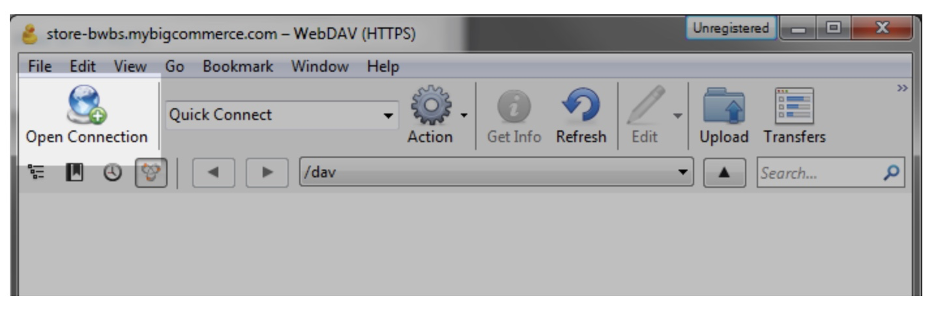
Enter the login details from the BigCommerce control panel into Cyberduck
- Server: Enter the WebDAV Path. The port 443 will fill itself, and /dav will go to the Path field automatically.
- Username — The email address specified under WebDAV username
- Password — This is the Password for WebDAV.
To enter your username and password, you may need to uncheck the Anonymous Login check box.
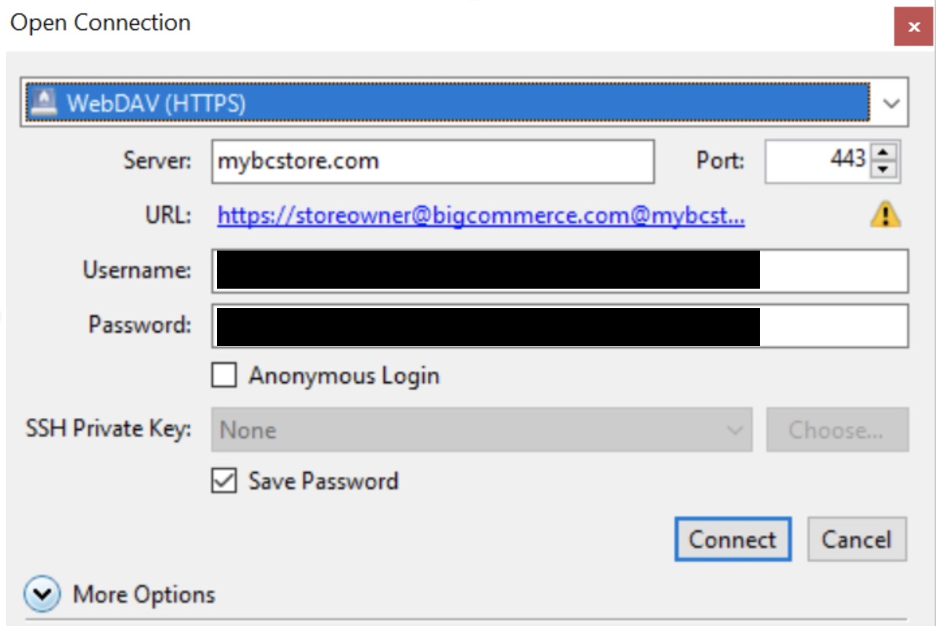
Connect by clicking the Connect button. Once you’ve successfully logged in, you’ll be able to see the folders of your shop.
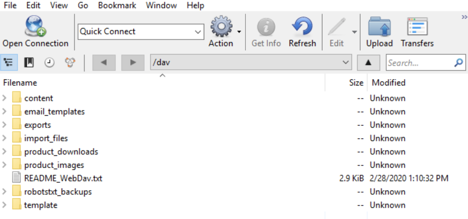
If you’ve signed in, double-check that the following settings are in place:
- Make sure the checkbox next to “Save Workspace” is unchecked in the General tab > Edit > Preferences

- Select the Transfers tab. Transfer Files should be set to Open several connections.

Folder Structure.
Below are the WebDAV folders that reside in the root directory (called dav), as well as subfolders that are specifically connected to a BigCommerce feature.
It’s important to remember that WebDAV is case-sensitive. The following directories are listed in their proper lowercase format.
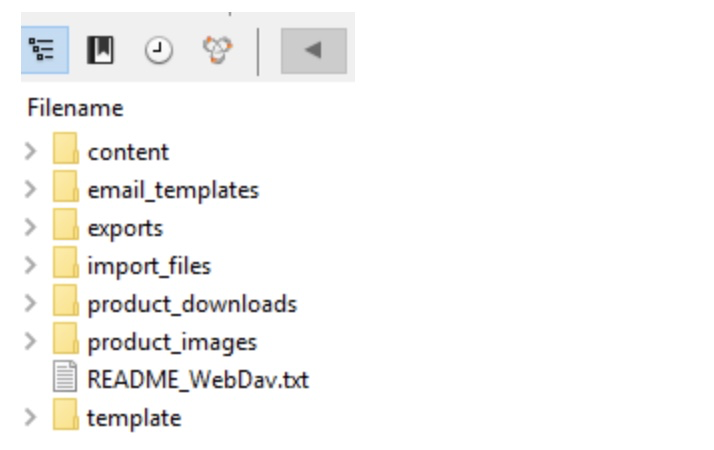
-
content — Store files that are not relevant to design or products, such as PDFs.
-
exports — You can download CSVs you have saved onto the server
-
import_files — Save large CSV files you want to import from the server
-
product_downloads — Store product files that can be downloaded in this folder. After being uploaded, they will be renamed and transferred to subfolders randomly.
- import — Upload product files that are downloadable to this folder. Then create your product and select Use a file already on the server.
- product_images — Store items’ images in this folder. After being uploaded, they will be renamed and tranfered to subfolders randomly.
- configured_products — You can see all store files uploaded by customers when using a File Upload option. You may want to delete these files after the order is complete.
-
import — Store product images ready to be uploaded via CSV import.
-
uploaded_images — Synchronize images with the Image Manager.
-
-
template — Keep track of custom assets for your store’s layout. Both custom properties should be stored in the subfolders assigned to them. This folder will be blank by default.
- mobile template — Custom assets for the mobile template can be saved here. This folder will be empty, much like the template folder, and all custom properties should be put within their assigned subfolders.
How to use Cyberduck?
Before we can begin, we are going to need three important pieces of information: the hostname, your username, and your password. See more in Find your login information
Now that you have collected the needed information, we can begin by clicking the “open connection” icon to open the site manager using the information we gathered earlier.
Simply fill in the blanks. Where it says server, you have to input ftp.hostedftp.com or your branded domain name. Then type in your username and password.
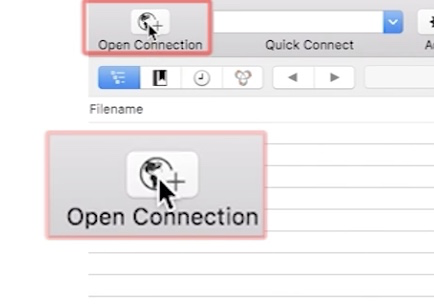
Basic FTP users can click connect right away for unsecured transferring. Or, you can use the dropdown menu to select a different protocol that is safer.
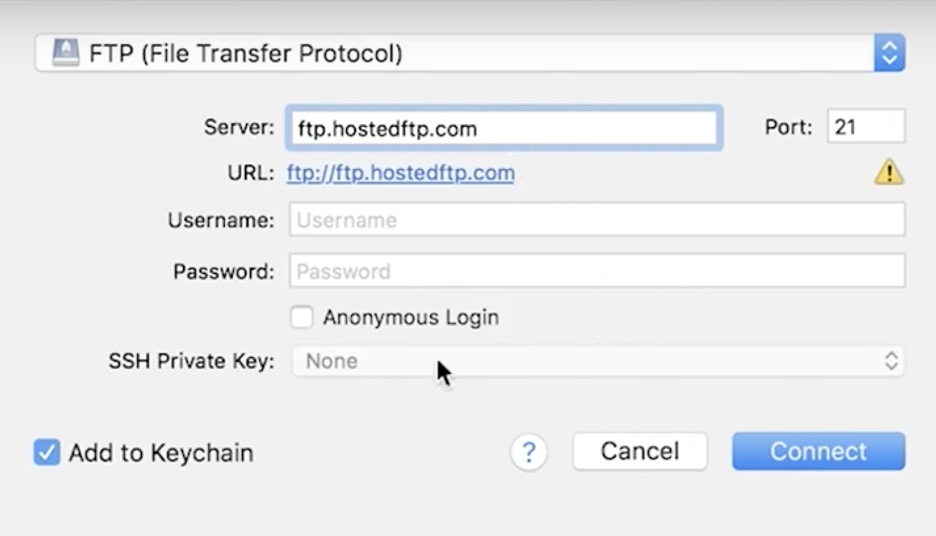
If you’re using FTPs, you may be required to open port 21 and 1200 to 2000 on your firewall. We suggest using the SFTP protocol as it provides just as much security as FTPS and only requires you to open port 22.
When you connect, you will get the unknown fingerprint notification, which asks you if you trust a connection with your hosts. You can click allow to continue or deny to disconnect.

Now that you’re connected, you can transfer files to and from your server. To upload a file or folder, right-click and select upload or click the upload icon.
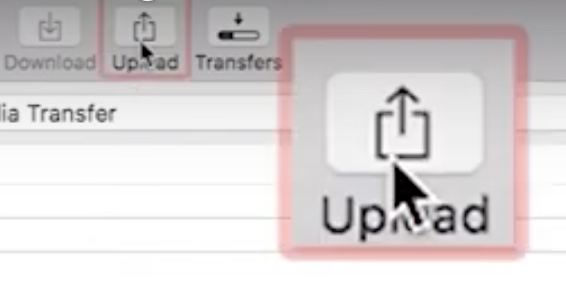
Browse your computer, often referred to as your local site, to find the file or folder you want to upload, or you can use your cursor to select multiple files or folders simultaneously for uploading.

Once you click upload, the transfer queue will open, so you can view the speed status and priority of your uploads.

If you want to download a file or folder, you need to highlight the folder or file you want to transfer and right-click to select “download,” “download as” or “download to” to choose the destination of your download. Again, you can use your cursor to select multiple files or folders for download.

The transfer queue will open once again so you can view the speed status and priority of your downloads
Alternatively, you can also drag and drop to and from your desktop through the Cyberduck interface to upload or download files or folders.

Final thoughts.
Despite its reputation as an old-fashioned method, WebDAV has proven to be a valuable tool for prominent cloud storage companies in providing smooth local access to remote data. Job collaboration, project management, shared authoring, development coordination, telecommuting, and cloud computing are examples of modern working processes that WebDAV has been able to deliver for decades.
WebDAV was ahead of the competition in several cases, and companies are just starting to use the full range of WebDAV’s capabilities. When the right servers and clients are matched, WebDAV is a muscular workhorse, and you can use it in a variety of applications.





